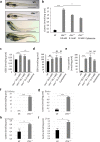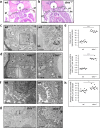Cystinosis (ctns) zebrafish mutant shows pronephric glomerular and tubular dysfunction
- PMID: 28198397
- PMCID: PMC5309805
- DOI: 10.1038/srep42583
Cystinosis (ctns) zebrafish mutant shows pronephric glomerular and tubular dysfunction
Abstract
The human ubiquitous protein cystinosin is responsible for transporting the disulphide amino acid cystine from the lysosomal compartment into the cytosol. In humans, Pathogenic mutations of CTNS lead to defective cystinosin function, intralysosomal cystine accumulation and the development of cystinosis. Kidneys are initially affected with generalized proximal tubular dysfunction (renal Fanconi syndrome), then the disease rapidly affects glomeruli and progresses towards end stage renal failure and multiple organ dysfunction. Animal models of cystinosis are limited, with only a Ctns knockout mouse reported, showing cystine accumulation and late signs of tubular dysfunction but lacking the glomerular phenotype. We established and characterized a mutant zebrafish model with a homozygous nonsense mutation (c.706 C > T; p.Q236X) in exon 8 of ctns. Cystinotic mutant larvae showed cystine accumulation, delayed development, and signs of pronephric glomerular and tubular dysfunction mimicking the early phenotype of human cystinotic patients. Furthermore, cystinotic larvae showed a significantly increased rate of apoptosis that could be ameliorated with cysteamine, the human cystine depleting therapy. Our data demonstrate that, ctns gene is essential for zebrafish pronephric podocyte and proximal tubular function and that the ctns-mutant can be used for studying the disease pathogenic mechanisms and for testing novel therapies for cystinosis.
Conflict of interest statement
The authors declare no competing financial interests.
Figures







References
-
- Town M. et al.. A novel gene encoding an integral membrane protein is mutated in nephropathic cystinosis. Nat. Genet. 18, 319–324 (1998). - PubMed
-
- Gahl W. A., Thoene J. G. & Schneider J. A. Cystinosis. N. Engl. J. Med. 347, 111–121 (2002). - PubMed
-
- Greco M., Brugnara M., Zaffanello M., Taranta A., Pastore A. & Emma F. Long-term outcome of nephropathic cystinosis: a 20-year single-center experience. Pediatr. Nephrol. 25, 2459–2467 (2010). - PubMed
-
- Ivanova E. A. et al.. Altered mTOR signalling in nephropathic cystinosis. J. Inherit. Metab. Dis. l39, 457–464 (2016). - PubMed
Publication types
MeSH terms
Substances
LinkOut - more resources
Full Text Sources
Other Literature Sources
Molecular Biology Databases

